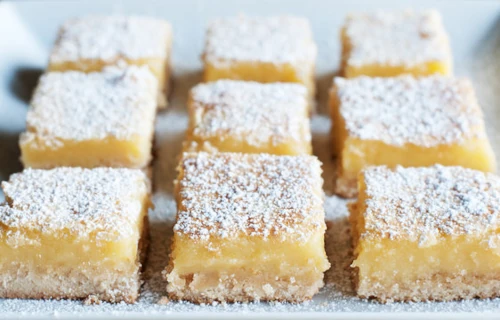Lemon Bars

Today in Granny's kitchen we're serving up a taste of the South with our Lemon Bars. This sweet and tangy dessert is a celebration of the simple, comforting flavors of fresh lemons and a buttery shortbread crust. It's a dessert that's as delightful as it is delicious, a testament to the Southern tradition of making the most of simple, readily available ingredients.
Perfect for any occasion, our Lemon Bars are a wonderful treat to enjoy with a cup of tea or as a sweet ending to a meal. The tangy flavors of the lemon filling complement the sweet, buttery crust, creating a balanced dessert that's just right for any sweet tooth. But don't let the name fool you; these bars aren't just for dessert. They're also a perfect snack, offering a refreshing treat for those moments when you need a little pick-me-up.

Ingredients
½ cup unsalted butter, melted ¼ cup granulated sugar 1 teaspoon pure vanilla extract ¼ teaspoon salt 1 cups + 1 Tablespoon all-purpose flour 1 cup granulated sugar 3 Tablespoons all-purpose flour 3 large eggs ½ cup lemon juice Confectioners’ sugar for dusting
Method
- 1. Preheat the oven to 325°F. Line a 9×9 baking pan with parchment paper.
- 2. Mix the melted butter, sugar, vanilla extract, and salt together. Add the flour and stir to combine. Press the dough into the pan and bake for 20-22 minutes. Remove from the oven and poke holes all over the top of the crust.
- 3. Sift the sugar and flour together. Add the eggs and lemon juice and whisk until combined. Pour the filling over the warm crust.
- 4. Bake the bars for 22-26 minutes or until the center is set. Remove bars from the oven and cool completely at room temperature, then refrigerate until chilled.
- 5. Once cool, lift the parchment paper out of the pan, dust with confectioners’ sugar and cut into squares. Store leftover lemon bars in the refrigerator for up to 1 week.

Lemon Bars: A Sweet and Tangy Delight
Lemon bars, a classic American dessert, have a history as rich and tangy as their flavor. While the exact origin of this dessert is unclear, it's widely accepted that they gained significant popularity in the 1960s. The first widely published recipe for lemon bars appeared in the Chicago Daily Tribune on August 27, 1962. This recipe quickly caught the attention of home bakers and dessert lovers alike, marking the beginning of the lemon bar's rise to fame.
The dessert's popularity was further cemented when a similar recipe was featured in the 1963 edition of the Betty Crocker's Cooky Book. This recipe, like the one in the Chicago Daily Tribune, highlighted the dessert's two main components: a buttery shortbread crust and a tangy lemon curd filling. The simplicity of these elements, combined with the contrasting textures and flavors they offered, made lemon bars an instant hit.
The lemon bar's popularity has endured over the decades, and it's now a staple at many American events and celebrations. From picnics and bake sales to baby showers and bridal showers, these tangy treats are a crowd-pleaser. They're also a favorite for home bakers, thanks to their straightforward recipe and easily accessible ingredients.
The two main components of a lemon bar, the shortbread crust and the lemon curd, each have their own unique history. Shortbread originated in Scotland as far back as the 12th century, while lemon curd dates back to 19th century England. The combination of these two elements in the form of a lemon bar is a relatively recent innovation, but one that has clearly resonated with dessert lovers.
In the present day, lemon bars continue to be a beloved dessert. They're often served dusted with confectioners sugar or alongside a cup of tea or coffee. Some bakers have even started to experiment with variations on the classic recipe, introducing new flavors or catering to dietary restrictions with gluten-free or vegan options.
Lemon Bars are more than just a sweet treat. They're a piece of culinary history, a dish that tells a story of adaptation, resourcefulness, and the blending of cultures. It's a testament to the rich culinary tradition of the Southern United States, a tradition that continues to influence and shape American cuisine today.